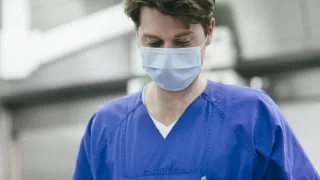Finnish Institute of Occupational Health media release, 12 January 2022
“Due to the increasing sickness absences, the situation in workplaces is now different from what it was at the start of the pandemic. In addition to occupational safety and health, employers must also ensure that mild cases of COVID-19 will not interrupt the operational order-supply chains in the next few weeks,” says Antti Koivula, Director General of the Finnish Institute of Occupational Health.
“The increasing number of sickness absences can make the situation more difficult for the whole society. For example, closing down a hospital due to insufficient personnel or suffering a temporary interruption in energy production can cause considerable harm,” Koivula continues.
Vaccinations, distances, hygiene, facemasks, remote work and smart organization of work remain important
What can be done in workplaces to ensure functional capacity?
The methods are familiar:
- Encouraging employees to get vaccinated must continue.
- Appropriate distances must be ensured.
- Facemasks must be worn and they must be made available to both clients and employees.
- The use of respirators should be increased according to the risk assessment. Protective equipment must be worn according to the instructions.
- Good hand and coughing hygiene must be ensured and people must be reminded about them.
- Remote work and remote meetings must be implemented whenever possible.
- Encounters must be avoided: breaks can be staggered.
- Self-certified sickness absences should be allowed. When a person can, upon their own report and without a medical certificate, be on sick leave for 3–7 days, healthcare does not become strained and people suffering from a common cold stay at home.
Considering critical operations
In order to ensure the operational activities of companies and other organizations, attention should be paid to the ensuring of critical operation processes. The use of FFP2 protective equipment should be considered as one protective measure.
When the virus is prevalent, an FFP2 respirator protects the wearer from the airborne Omicron better than a surgical mask. Unvaccinated people in particular should consider wearing FFP2 protective equipment. The respirator must stay on the face firmly and people must be instructed on how to use respirators correctly. Further information about facemasks and respirators is available on the “Corona and Work” webpages of the Finnish Institute of Occupational Health: Information on face masks, surgical masks and respirators
“It is safe to assume that the following months will be challenging for many workplaces as the number of sickness absences caused by mild cases of COVID-19 increases. This is why we encourage workplaces to expand the use of self-certified sickness absences and view the current situation as an opportunity to enhance the internal trust of the work community,” Koivula says.
More information on the “Corona and Work” webpages:
- Instructions for workplaces for assessing the risk of COVID-19 infections
- Guidelines for employers
- Information on face masks, surgical masks and respirators
- Recommendation on the use of face masks for citizens (THL)
Further information
Antti Koivula, Director General, Finnish Institute of Occupational Health, tel. +358 30 4742341, antti.koivula [at] ttl.fi
Eva Helaskoski, Director, Chief Medical Officer, Finnish Institute of Occupational Health, tel. +358 46 851 2432, eva.helaskoski [at] ttl.fi
Erja Mäkelä, Senior Adviser (respirators), Finnish Institute of Occupational Health, tel. +358 30 474 2595, erja.makela [at] ttl.fi






